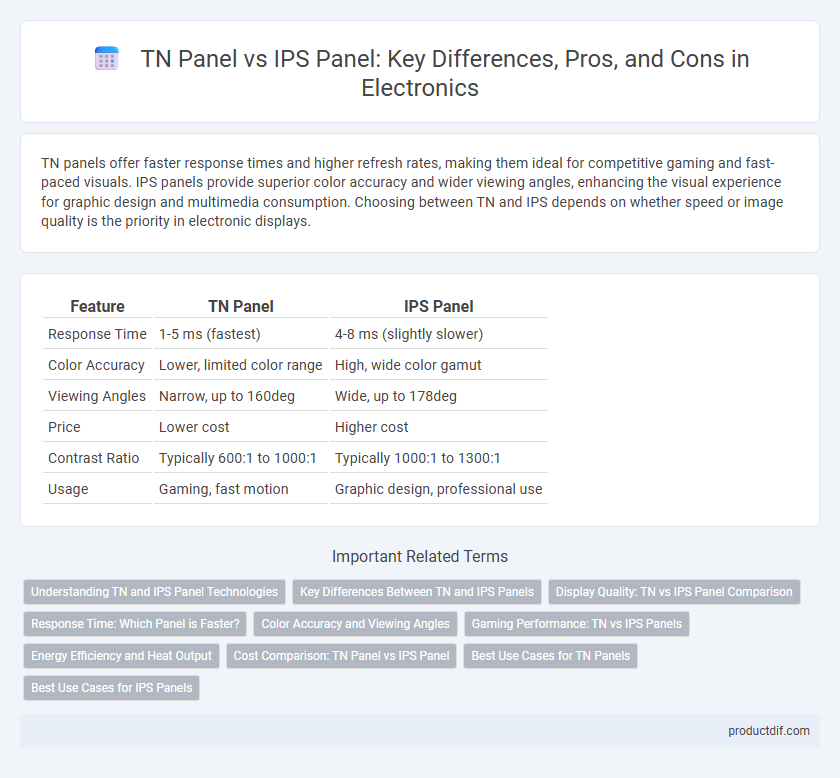TN panels offer faster response times and higher refresh rates, making them ideal for competitive gaming and fast-paced visuals. IPS panels provide superior color accuracy and wider viewing angles, enhancing the visual experience for graphic design and multimedia consumption. Choosing between TN and IPS depends on whether speed or image quality is the priority in electronic displays.
Table of Comparison
| Feature | TN Panel | IPS Panel |
|---|---|---|
| Response Time | 1-5 ms (fastest) | 4-8 ms (slightly slower) |
| Color Accuracy | Lower, limited color range | High, wide color gamut |
| Viewing Angles | Narrow, up to 160deg | Wide, up to 178deg |
| Price | Lower cost | Higher cost |
| Contrast Ratio | Typically 600:1 to 1000:1 | Typically 1000:1 to 1300:1 |
| Usage | Gaming, fast motion | Graphic design, professional use |
Understanding TN and IPS Panel Technologies
TN (Twisted Nematic) panels offer faster refresh rates and lower response times, making them ideal for competitive gaming but often suffer from limited viewing angles and color accuracy. IPS (In-Plane Switching) panels provide superior color reproduction and wider viewing angles, enhancing visual quality for multimedia and professional use, though they typically have slower response times compared to TN panels. Understanding the balance between speed and image quality is essential when choosing between TN and IPS panel technologies in electronic displays.
Key Differences Between TN and IPS Panels
TN panels offer faster response times and higher refresh rates, making them ideal for competitive gaming scenarios, while IPS panels provide superior color accuracy and wider viewing angles suitable for graphic design and multimedia consumption. TN technology uses twisted nematic liquid crystals that quickly change orientation, resulting in reduced motion blur but limited color reproduction compared to IPS's in-plane switching method, which maintains consistent colors from different viewing positions. Key differences also include TN's generally lower cost and energy consumption against IPS panels' higher price and better visual performance.
Display Quality: TN vs IPS Panel Comparison
IPS panels deliver superior display quality with wider viewing angles and more accurate color reproduction compared to TN panels, which often suffer from color shifting and limited viewing angles. TN panels typically offer faster response times, making them suitable for gaming, but their image quality is generally inferior due to lower contrast and poorer color fidelity. When prioritizing color accuracy and vibrant visuals, IPS panels are the preferred choice for professional and multimedia applications.
Response Time: Which Panel is Faster?
TN panels typically offer faster response times ranging from 1ms to 5ms, making them ideal for fast-paced gaming and high-speed applications. IPS panels generally have slower response times, usually between 4ms and 8ms, but provide superior color accuracy and wider viewing angles. For users prioritizing speed and minimal motion blur, TN panels remain the preferred choice over IPS panels.
Color Accuracy and Viewing Angles
TN panels offer faster response times but suffer from limited color accuracy and narrower viewing angles, making them less ideal for color-critical tasks. IPS panels provide superior color reproduction and maintain consistent color fidelity across wide viewing angles, making them the preferred choice for graphic design, photo editing, and professional use. The enhanced color accuracy and stable viewing experience of IPS panels justify their higher cost compared to TN panels.
Gaming Performance: TN vs IPS Panels
TN panels offer faster response times typically around 1ms, making them ideal for competitive gaming where minimal motion blur is crucial. IPS panels provide superior color accuracy and wider viewing angles but usually have response times around 4-5ms, which can introduce slight ghosting in fast-paced games. Gamers seeking a balance between image quality and performance may prefer IPS, while those prioritizing ultra-fast responsiveness often choose TN panels.
Energy Efficiency and Heat Output
TN panels typically consume less power and produce lower heat output compared to IPS panels due to their simpler liquid crystal structure and faster response times. IPS panels, while offering superior color accuracy and viewing angles, tend to require more energy, resulting in higher thermal dissipation during prolonged use. Energy efficiency considerations are crucial for devices aiming to minimize heat buildup and extend battery life, especially in portable electronics and energy-conscious environments.
Cost Comparison: TN Panel vs IPS Panel
TN panels typically offer a more budget-friendly option compared to IPS panels, making them ideal for cost-sensitive consumers and basic computing needs. IPS panels, while generally more expensive, provide superior color accuracy and wider viewing angles, justifying the higher price for professional graphic work and multimedia consumption. The cost difference largely stems from IPS technology's enhanced liquid crystal alignment and manufacturing complexity.
Best Use Cases for TN Panels
TN panels excel in competitive gaming due to their fastest response times, typically around 1ms, reducing motion blur and ghosting significantly. Their high refresh rates, often reaching 240Hz or higher, make them ideal for fast-paced action where rapid screen updates are crucial. Despite narrower viewing angles and lower color accuracy compared to IPS panels, TN displays remain preferred for budget-friendly setups focused on performance and speed.
Best Use Cases for IPS Panels
IPS panels offer superior color accuracy and wider viewing angles, making them ideal for graphic design, photo editing, and professional video production where precise color representation is crucial. Their consistent image quality across different angles enhances collaboration in office environments and improves the overall user experience for multimedia consumption. IPS technology also supports faster response times than traditional TN panels, benefiting gamers and users requiring vibrant visuals.
TN Panel vs IPS Panel Infographic

 productdif.com
productdif.com